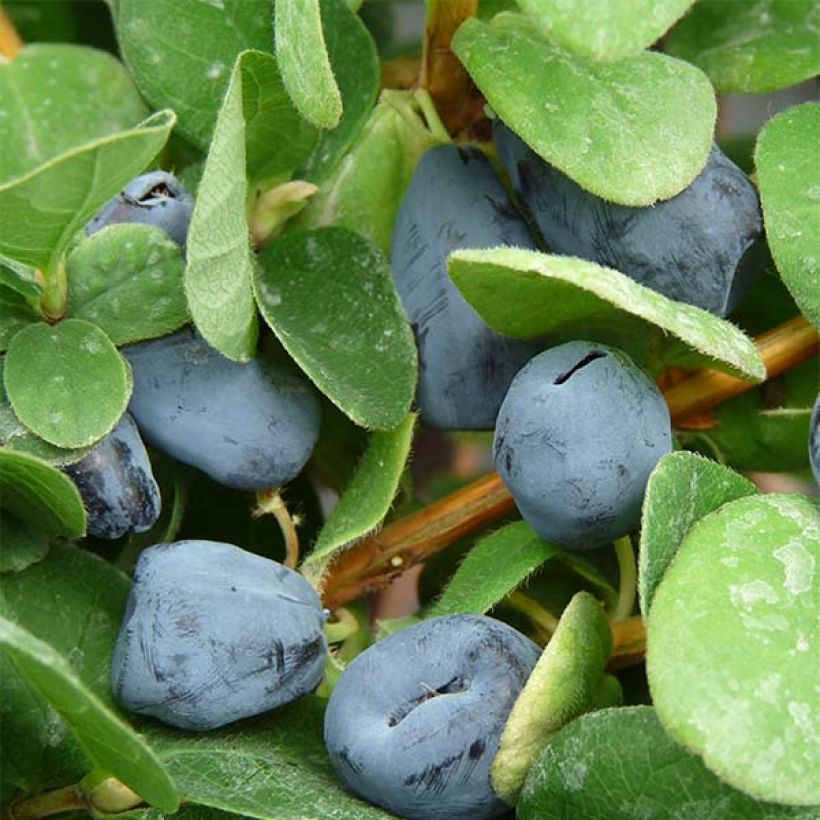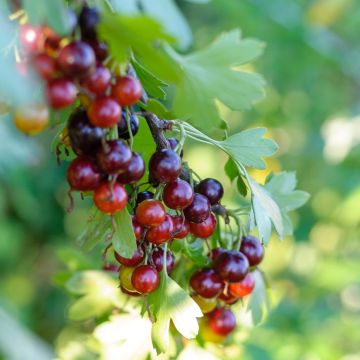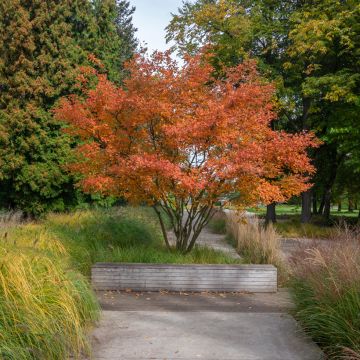

Lonicera caerulea kamtschatica Duet - Honeyberry
Lonicera caerulea kamtschatica Duet - Honeyberry
Lonicera caerulea var. kamtschatica Duet
Blue Honeysuckle, Honeyberry, Sweetberry Honeysuckle, Haskap
The berries of May have arrived in good condition. I am satisfied.
Chala , 04/12/2023
Special offer!
Receive a €20 voucher for any order over €90 (excluding delivery costs, credit notes, and plastic-free options)!
1- Add your favorite plants to your cart.
2- Once you have reached €90, confirm your order (you can even choose the delivery date!).
3- As soon as your order is shipped, you will receive an email containing your voucher code, valid for 3 months (90 days).
Your voucher is unique and can only be used once, for any order with a minimum value of €20, excluding delivery costs.
Can be combined with other current offers, non-divisible and non-refundable.
Home or relay delivery (depending on size and destination)
Schedule delivery date,
and select date in basket
This plant carries a 6 months recovery warranty
More information
We guarantee the quality of our plants for a full growing cycle, and will replace at our expense any plant that fails to recover under normal climatic and planting conditions.

Description
Lonicera kamtschatica Duet is a variety that produces elongated berries, 2 cm (0.8 in) in size, which are a blue colour with a honey-like smell. They have a tart taste similar to blueberries and kiwis, and can be consumed fresh or used in jams, jellies, and juices. It is recommended to plant at least two bushes for good fruiting. It is a hardy bush shrub. Planting can be done in autumn or spring for harvesting in May and June.
Lonicera kamtschatica is a bushy shrub reaching a height of 1 to 1.50 meters (3 feet to 5 feet) and a width of 1 meter (3 feet 4 inches). This shrub is native to Siberia and is very hardy, capable of withstanding temperatures as low as -40°C (-40 °F). It belongs to the Caprofoliaceae family and the Lonicera species, like honeysuckle. Its deciduous leaves are ovate and elongated.
Flowering for this variety occurs as early as March, with small yellow flowers which then transform into small blue fruits around May. These berries frosted and have an elongated shape, approximately 2 cm long and 0.5 cm (0.2 in) in diameter. They have a tart taste similar to blueberries and kiwis. Rich in vitamins B and C, they can be consumed fresh, used in jams, jellies, juices, or frozen. When cooked, the flesh turns a mahogany red colour.
In the garden, Lonicera kamtschatica can be grown as a hedge or in flower beds. It thrives in moist soils but is sensitive to dry and chalky soils. To ensure proper pollination and fruiting, it is recommended to plant at least two bushes.
Lonicera caerulea kamtschatica Duet - Honeyberry in pictures




Plant habit
Fruit
Flowering
Foliage
Botanical data
Lonicera
caerulea var. kamtschatica
Duet
Caprifoliaceae
Blue Honeysuckle, Honeyberry, Sweetberry Honeysuckle, Haskap
Russia
Other Berries A to Z
View all →Planting and care
The Honeyberry appreciates moist soils and dislikes dry and very chalky soils. Choose a sunny or semi-shaded position in hot regions. Planting should take place in autumn or spring. Space the plants about 60 cm (23.6 in) to 1 m (3 ft 4 in) apart.
Soak the root ball for a few moments before planting. As the Honeyberry dislikes dry soils, add a slurry made of water and compost to the bottom of the planting hole. Add the young plant, cover with soil and compact the soil to form a small watering basin. Water.
During the summer, apply a mulch at the base to retain freshness and moisture.
It is also possible to grow this plant in a pot.
Planting period
Intended location
Care
Planting & care advice
-
, onOrder confirmed
Reply from on Promesse de fleurs
Similar products
Haven't found what you were looking for?
Hardiness is the lowest winter temperature a plant can endure without suffering serious damage or even dying. However, hardiness is affected by location (a sheltered area, such as a patio), protection (winter cover) and soil type (hardiness is improved by well-drained soil).

Photo Sharing Terms & Conditions
In order to encourage gardeners to interact and share their experiences, Promesse de fleurs offers various media enabling content to be uploaded onto its Site - in particular via the ‘Photo sharing’ module.
The User agrees to refrain from:
- Posting any content that is illegal, prejudicial, insulting, racist, inciteful to hatred, revisionist, contrary to public decency, that infringes on privacy or on the privacy rights of third parties, in particular the publicity rights of persons and goods, intellectual property rights, or the right to privacy.
- Submitting content on behalf of a third party;
- Impersonate the identity of a third party and/or publish any personal information about a third party;
In general, the User undertakes to refrain from any unethical behaviour.
All Content (in particular text, comments, files, images, photos, videos, creative works, etc.), which may be subject to property or intellectual property rights, image or other private rights, shall remain the property of the User, subject to the limited rights granted by the terms of the licence granted by Promesse de fleurs as stated below. Users are at liberty to publish or not to publish such Content on the Site, notably via the ‘Photo Sharing’ facility, and accept that this Content shall be made public and freely accessible, notably on the Internet.
Users further acknowledge, undertake to have ,and guarantee that they hold all necessary rights and permissions to publish such material on the Site, in particular with regard to the legislation in force pertaining to any privacy, property, intellectual property, image, or contractual rights, or rights of any other nature. By publishing such Content on the Site, Users acknowledge accepting full liability as publishers of the Content within the meaning of the law, and grant Promesse de fleurs, free of charge, an inclusive, worldwide licence for the said Content for the entire duration of its publication, including all reproduction, representation, up/downloading, displaying, performing, transmission, and storage rights.
Users also grant permission for their name to be linked to the Content and accept that this link may not always be made available.
By engaging in posting material, Users consent to their Content becoming automatically accessible on the Internet, in particular on other sites and/or blogs and/or web pages of the Promesse de fleurs site, including in particular social pages and the Promesse de fleurs catalogue.
Users may secure the removal of entrusted content free of charge by issuing a simple request via our contact form.
The flowering period indicated on our website applies to countries and regions located in USDA zone 8 (France, the United Kingdom, Ireland, the Netherlands, etc.)
It will vary according to where you live:
- In zones 9 to 10 (Italy, Spain, Greece, etc.), flowering will occur about 2 to 4 weeks earlier.
- In zones 6 to 7 (Germany, Poland, Slovenia, and lower mountainous regions), flowering will be delayed by 2 to 3 weeks.
- In zone 5 (Central Europe, Scandinavia), blooming will be delayed by 3 to 5 weeks.
In temperate climates, pruning of spring-flowering shrubs (forsythia, spireas, etc.) should be done just after flowering.
Pruning of summer-flowering shrubs (Indian Lilac, Perovskia, etc.) can be done in winter or spring.
In cold regions as well as with frost-sensitive plants, avoid pruning too early when severe frosts may still occur.
The planting period indicated on our website applies to countries and regions located in USDA zone 8 (France, United Kingdom, Ireland, Netherlands).
It will vary according to where you live:
- In Mediterranean zones (Marseille, Madrid, Milan, etc.), autumn and winter are the best planting periods.
- In continental zones (Strasbourg, Munich, Vienna, etc.), delay planting by 2 to 3 weeks in spring and bring it forward by 2 to 4 weeks in autumn.
- In mountainous regions (the Alps, Pyrenees, Carpathians, etc.), it is best to plant in late spring (May-June) or late summer (August-September).
The harvesting period indicated on our website applies to countries and regions in USDA zone 8 (France, England, Ireland, the Netherlands).
In colder areas (Scandinavia, Poland, Austria...) fruit and vegetable harvests are likely to be delayed by 3-4 weeks.
In warmer areas (Italy, Spain, Greece, etc.), harvesting will probably take place earlier, depending on weather conditions.
The sowing periods indicated on our website apply to countries and regions within USDA Zone 8 (France, UK, Ireland, Netherlands).
In colder areas (Scandinavia, Poland, Austria...), delay any outdoor sowing by 3-4 weeks, or sow under glass.
In warmer climes (Italy, Spain, Greece, etc.), bring outdoor sowing forward by a few weeks.



























































